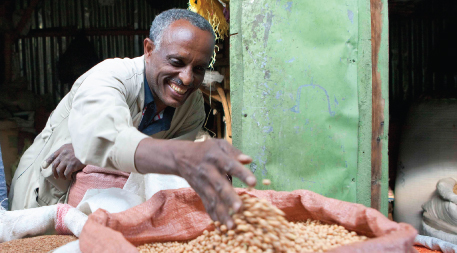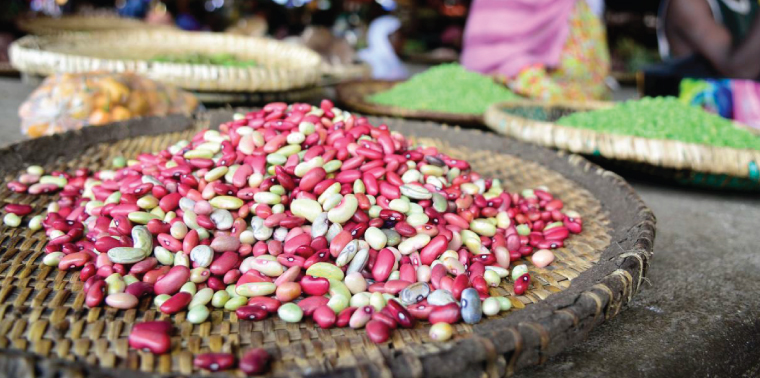September 9, 2013 — Lean and towering at 6 feet 5 inches, Ken Giller blends right into the rows of climbing beanstalks he is examining on this blisteringly hot spring day in Buhoro, a village in northern Rwanda. Local farmers who have been growing various varieties of beans bred for high yields and other desirable traits proudly show him their plots on the terraced hillside.
“Aren’t they beautiful?” Giller beams as he plucks a bean shoot from the red soil and slices open a marble-sized nodule on its root.
Giller, a professor of plant production systems at Wageningen University in the Netherlands, understands as much as anyone the critical role climbing beans, common beans, soybeans and other legumes can play in nourishing the planet’s burgeoning population in an environmentally sustainable way.
His book, Nitrogen Fixation in Tropical Cropping Systems, is considered a bible of sorts for
researchers and agricultural extension workers. It explains how symbiotic Rhizobia soil bacteria that live in nodules in the roots of legumes “fix” nitrogen — that is, convert nitrogen gas in the atmosphere into a form plants (and, eventually, the animals that eat plants) can use to make DNA and protein molecules on which all life depends.
“[T]he ability of beans to capture nitrogen from the air and fix it into nutritious protein presents a key opportunity to address the food security of the poor.” — Ken GillerUntil the invention of synthetic ammonia a century ago, farmers relied on legumes, along with manure, crop residue and guano as sources of nitrogen for their crops.
“Beans can be seen as free protein from the air,” Giller wrote recently. “In countries such as Rwanda, where farmers have little livestock, the ability of beans to capture nitrogen from the air and fix it into nutritious protein presents a key opportunity to address the food security of the poor.”
Giller heads an agricultural development program called N2Africa. Founded in 2009, N2Africa now spans more than a dozen countries in sub-Saharan Africa. It partners with local agricultural development and national crop-breeding programs to expand the farm area cropped with legumes, help link farmers to markets, enhance the nitrogen-fixing characteristics of legumes by inoculating them with selected strains of Rhizobia, and breed legume varieties that are more pest, disease and drought resistant and that provide higher nutritional value and crop yields.
Many Benefits
Simple and nondescript as they may appear on the vine or dried in bulk bins at grocery stores, legumes bear many benefits. Nutritionally, they boast a high protein content without the cholesterol of meat protein. Most legumes contain between 20 percent and 25 percent protein, with soybeans boasting roughly 40 percent, whereas wheat, rice and corn protein levels range from 7 percent to 14 percent, according to Vaclav Smil, distinguished professor emeritus of the University of Manitoba and a leading expert on nitrogen, legumes and agriculture. Legumes are also rich in nutrients, such as calcium, iron and zinc. Further, many of these versatile beans tend to mature earlier than cereals, so they can break what is called the “hunger cycle” phenomenon among poor farmers.
Because legumes fix nitrogen, growers don’t need to use as much synthetic nitrogen fertilizer, which requires vast amounts of fossil fuels and other commercial energy sources to produce, according to Tim Crews, director of research and a research ecologist at The Land Institute, an agriculture and ecology research center in Salina, Kan. What’s more, legumes in general are more drought and pest resistant than cereals, and demand less irrigation in arid environments, according to Smil. And when used as cover crops, legumes — notably alfalfa, clovers and vetches — protect soil against erosion, Smil adds.
Ecologically, peas, beans and other legumes can help reduce the amount of nitrate (fertilizer nitrogen’s soluble form) that leaches off crop fields and contaminates groundwater, rivers and lakes. And economically, especially in developing countries, legumes can also help diversify and boost smallholder farmers’ household income. For instance, new high-yielding varieties are popular and fetch a high price at regional markets, and certain legumes, such as chickpeas grown in Ethiopia, have become a major cash crop for export to India.
“I personally think that if we could be satisfied eating beans as a protein source, oh my gosh, we would have so much less need for land used for grain production.” — Tim Crews Globally, legumes could be even more beneficial ecologically and nutritionally if more of them were cultivated for consumption by humans rather than livestock.
“I personally think that if we could be satisfied eating beans as a protein source, oh my gosh, we would have so much less need for land used for grain production,” says Crews. “Now we’re growing grain to run through animals, which is resource intensive and a huge source of nutrient contamination.”
Crews’ wish sounds utopian in the face of global demographic trends. Although Americans are tending to gorge a bit less on burgers and other meat, massive numbers of people in developing countries are climbing out of poverty and into the middle class, and as they do they’re eating more meat and dairy. Add to this trend another blow to legumes and their advocates: The U.S. and other governments, influenced by the powerful agribusiness lobby, subsidize commodity crops that favor meat consumption, such as nitrogen-responsive corn, and not — with the exception of soybean — legumes, or for that matter leafy vegetables.
“There’s very little public investment in these crops,” says Jeffrey Ehlers, a plant breeder geneticist. He is program officer with the Bill & Melinda Gates Foundation’s Research and Development Initiative of the Agricultural Development program. “Legumes have remained the orphan crops,” lacking a political constituency, Ehlers says. “They need someone to speak up for them.”
Filling the Gap
If governments have largely neglected legumes, some international agricultural organizations, and some hefty philanthropists such as Bill and Melinda Gates, are attempting to fill the gap, especially in developing countries in sub-Saharan Africa and south Asia. There, much of the arable land is still tilled by small-scale farmers, most of whom can’t afford or can’t get their hands on synthetic fertilizer.
The Gates Foundation has invested roughly $150 million in legume-based agricultural development programs, including some $45 million in N2Africa over the last seven years, according to Ehlers. Because of the nutritional, soil-improving and economic benefits of legumes, such campaigns fit into the foundation’s overarching goal of lifting smallholder famers out of hunger, malnutrition and poverty.
The Gates Foundation supports two sister projects — Tropical Legumes I (TL-I) and Tropical Legumes II (TL-II). The TL-I project, led by the International Maize and Wheat Improvement Center’s (CIMMYT) Generation Challenge Program, aims to speed up breeding and delivery of improved legume varieties, such as those that can better resist insects and diseases, through advances in genomics. The TL-II project is run by International Crops Research Institute for the Semi-Arid Tropics (ICRISAT). It also works on breeding improved legume varieties, as well as to get their seeds into the hands of small-holder farmers in Africa and South Asia. Further, the project is trying to boost productivity of six legume crops — groundnut, cowpea, common bean, chickpea, pigeonpea and soybean — by at least 20 percent, according to Ehlers. So far, the project has released 113 new legume varieties in the past six years in collaboration with national programs in the partner countries.

Strategic crop improvement projects have helped chickpea production soar in Ethiopia in recent years, boosting food security and household incomes. Photo by Swathi Sridharan/ICRISAT.
Ethiopia is a notable success story. Average yields of chickpeas have soared by 36 percent since the project began seven years ago, from 1.27 tons per hectare to 1.73 tons currently. Nationwide, production has increased by 57 percent to 399,630 tons during the same period, making Ethiopia the largest chickpea-producing nation in Africa and one of the top 10 chickpea producers globally. Market prices for chickpea, on average, have risen three- to fourfold in the past 15 years, Ehlers notes. As a result, farmers are selling more than three-quarters of the chickpeas they produce. Many chickpea farmers in Ethiopia have experienced large increases in net household income in the range of $1,000 per hectare, Ehlers adds. Considering the average household in Ethiopia earns between $1,000 and $2,000 per year, even cultivating half a hectare of the crop brings hefty financial boost to families.
A positive feedback loop has emerged. The new varieties are more productive and have better grain quality characteristics that fetch higher prices than the old varieties. That translates to higher returns for farmers. More cash, in turn, encourages the farmers to devote more of their limited arable land to growing chickpeas and to further adopt management practices — such as applying small amounts of fertilizer, shifting planting dates to more favorable times and spacing seeds more uniformly — that boost yields even more. As a result, the farmers have celebrated their chickpea yields more than doubling during the span of the project, Ehlers notes. So far, he adds, oversupply is not a problem largely because a chronic undersupply of chickpeas in South Asia has created export opportunities for growers in East Africa.
For all their magic, legumes are hardly a panacea for agriculture everywhere. In northern Rwanda, climbing beans such as the ones blanketing the hills of the villages N2Africa serves have largely replaced bush beans since varieties well adapted to the high-altitude mountain terrain were introduced in the 1980s. Along with local organizations, N2Africa has been testing more robust species. While these high-protein crops may be superior in some ways, they also created an unexpected complication: They required stakes to support them, and farmers began cutting down scarce or otherwise valuable trees to make the stakes. To avoid a Tragedy of the Commons disaster, farmers and N2Africa workers eventually started growing stiff-stemmed Napier grass to use as stakes and reusing stakes in subsequent seasons, according to Frederick Baijukya, who overseas N2Africa’s Rwanda projects.
Vexing Trade-Offs
For all their magic, legumes are hardly a panacea for agriculture everywhere. In fact, they come with some vexing trade-offs. For instance, pulse (edible) legumes produce inherently lower yields than do staple cereal crops, according to Crews of The Land Institute. Also, as many know painfully well, beans aren’t the best party food; they often induce flatulence due to the presence of indigestible sugars called oligosaccharides.
On a more consequential level, in some environments legume-based agriculture can “leak” nitrogen as much as crop fields doused with synthetic fertilizer. In fact, with advances in precision agriculture, some large-scale conventional crop systems can be much less leaky than those based on natural nitrogen fixation.
“At the end of the day, nitrate is nitrate,” says Luiz Martinelli, an associate professor of ecology at the University of São Paulo, Brazil. Whether from natural nitrogen fixation or mineral fertilizer, “nitrate could be leaching down into the soil profile and into rivers or transforming itself into nitrous oxide,” a potent greenhouse gas.
Martinelli knows this well. Roughly one-third of arable land in Brazil is devoted to soybean cultivation, Martinelli notes. Most of the soybeans grown there are shipped to China and Europe to feed pigs and other livestock. Thanks largely to government investment in breeding soybeans to fix nitrogen even more than they naturally would, growers do not need to apply mineral nitrogen fertilizer to the fields. That spares farmers the high cost of buying and applying fertilizer inputs, and, at least in theory, it’s better for the environment. But since so much more land in recent years has been converted from livestock to soybean cultivation, more nitrate is likely leaching through the soil and morphing into nitrous oxide, Martinelli says. Granted, pastures also generate a lot of nutrient runoff from manure.
“It’s just so complicated,” says Martinelli. “We’re trying to measure what’s really happening with all these changes in agriculture.”
Despite the caveats, however, legumes are increasingly drawing attention among scientists and farmers as a valuable resource for improving food production and alleviating poverty without further ravaging the environment.
“It’s not just that legumes are good or bad,” says Martinelli. “But overall, especially for smallholding farmers, legumes as nitrogen fixers are economically and ecologically really good. You can’t deny that.” ![]()
Ensia shares solutions-focused stories free of charge through our online magazine and partner media. That means audiences around the world have ready access to stories that can — and do — help them shape a better future. If you value our work, please show your support today.
Yes, I'll support Ensia!
